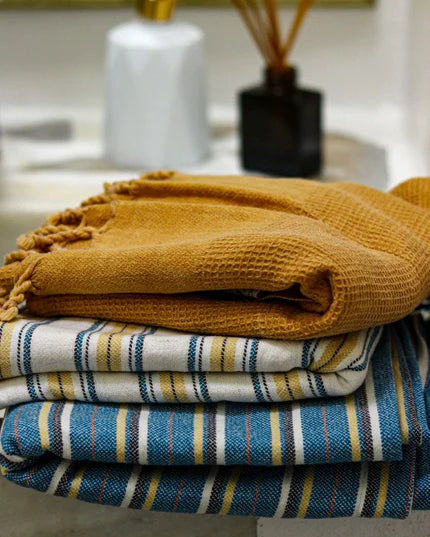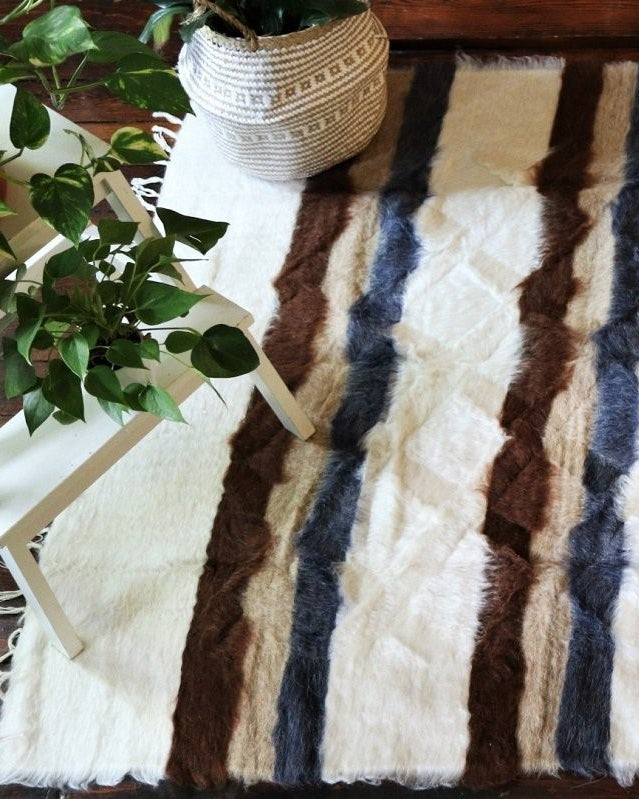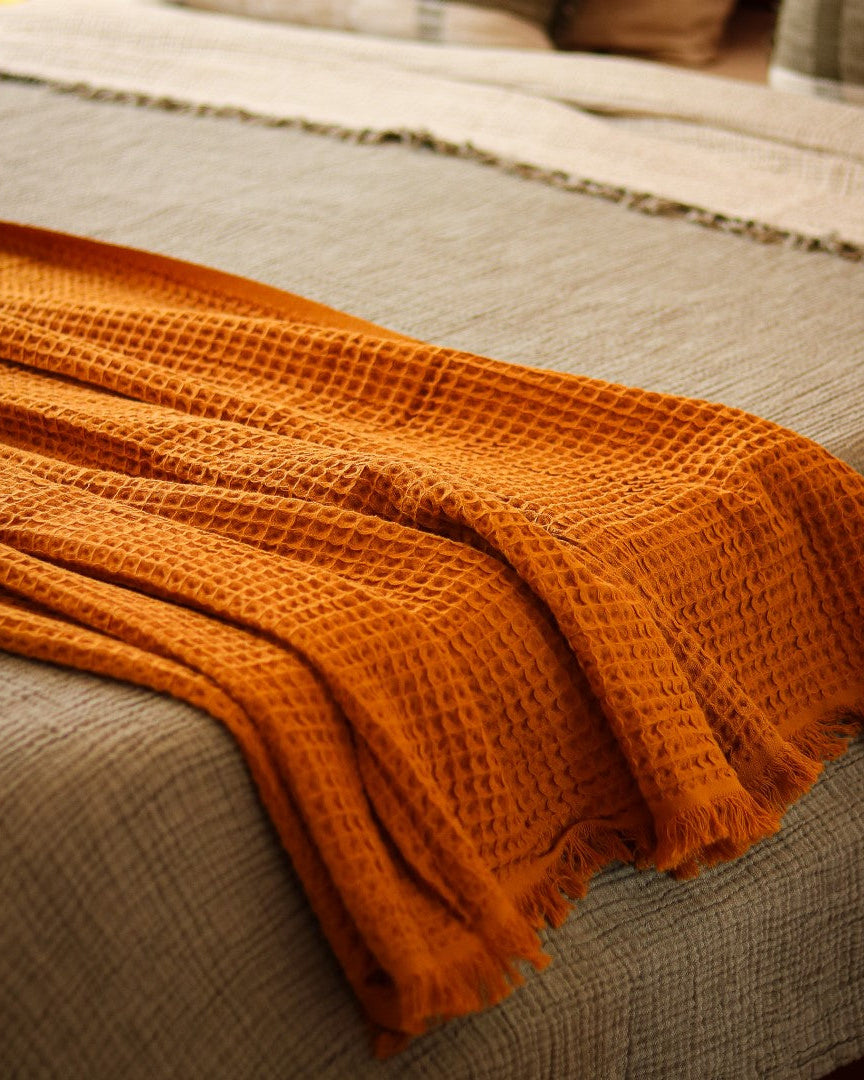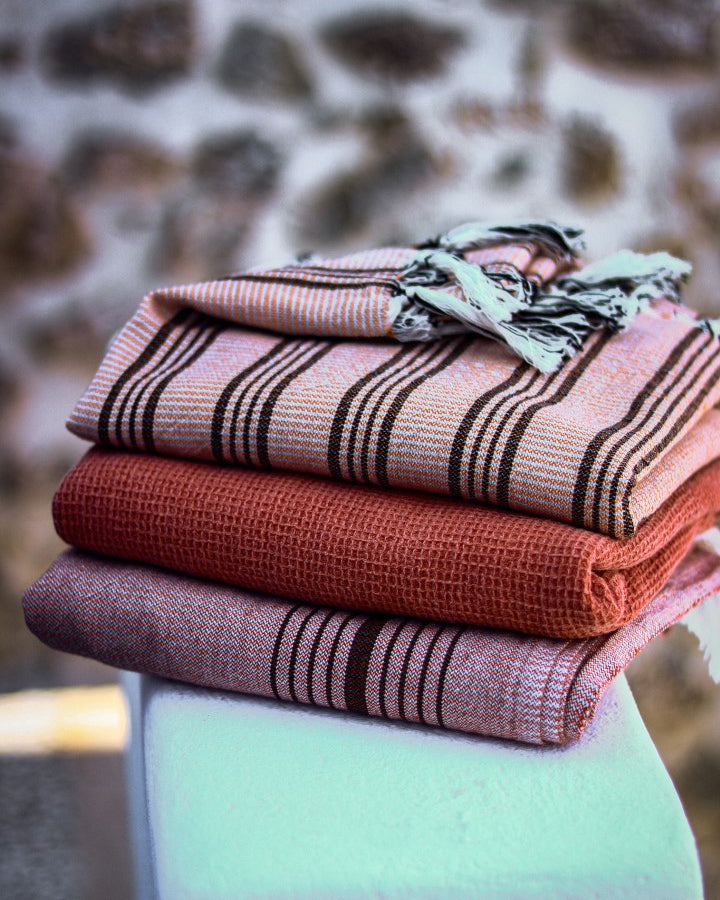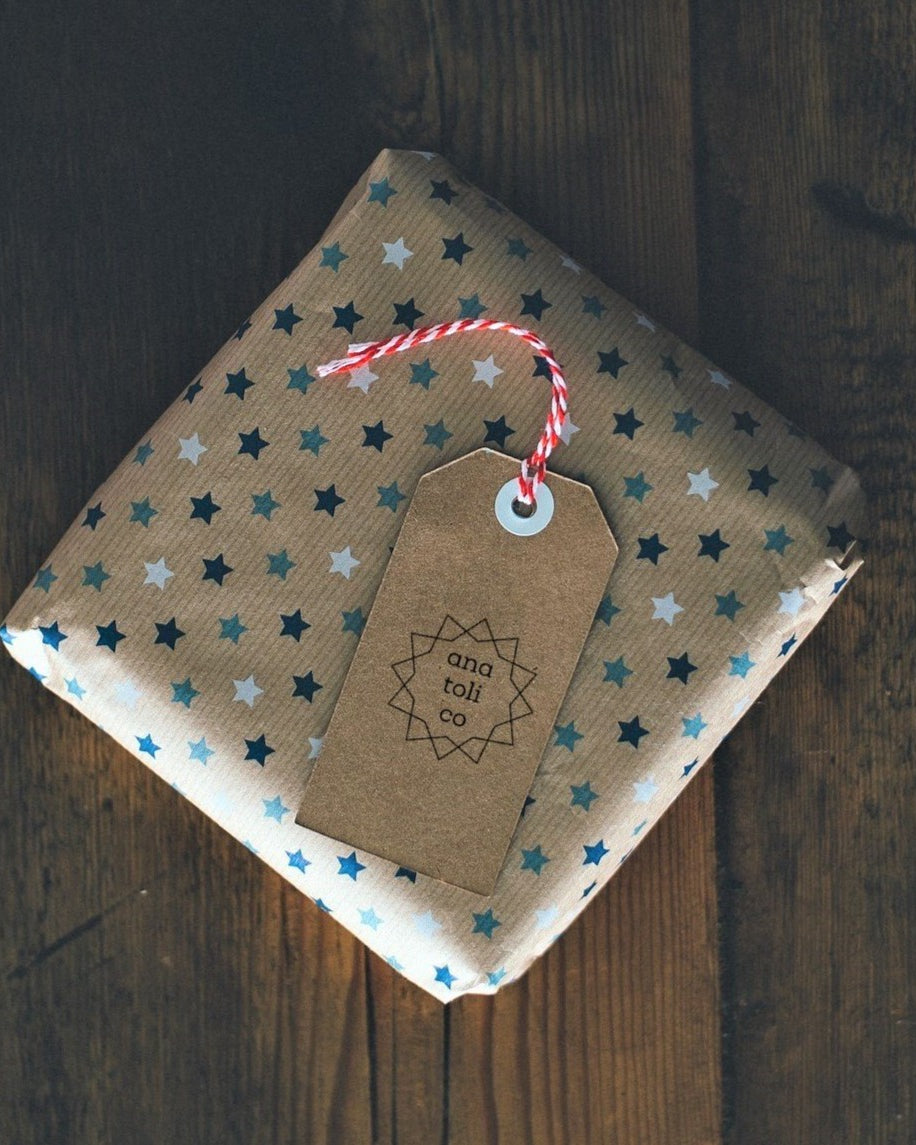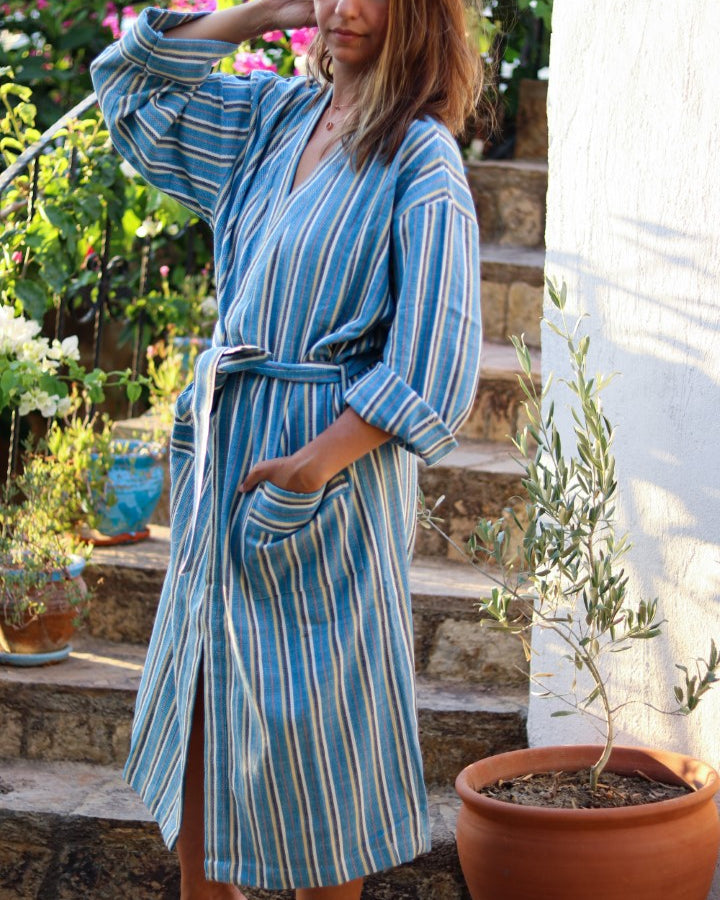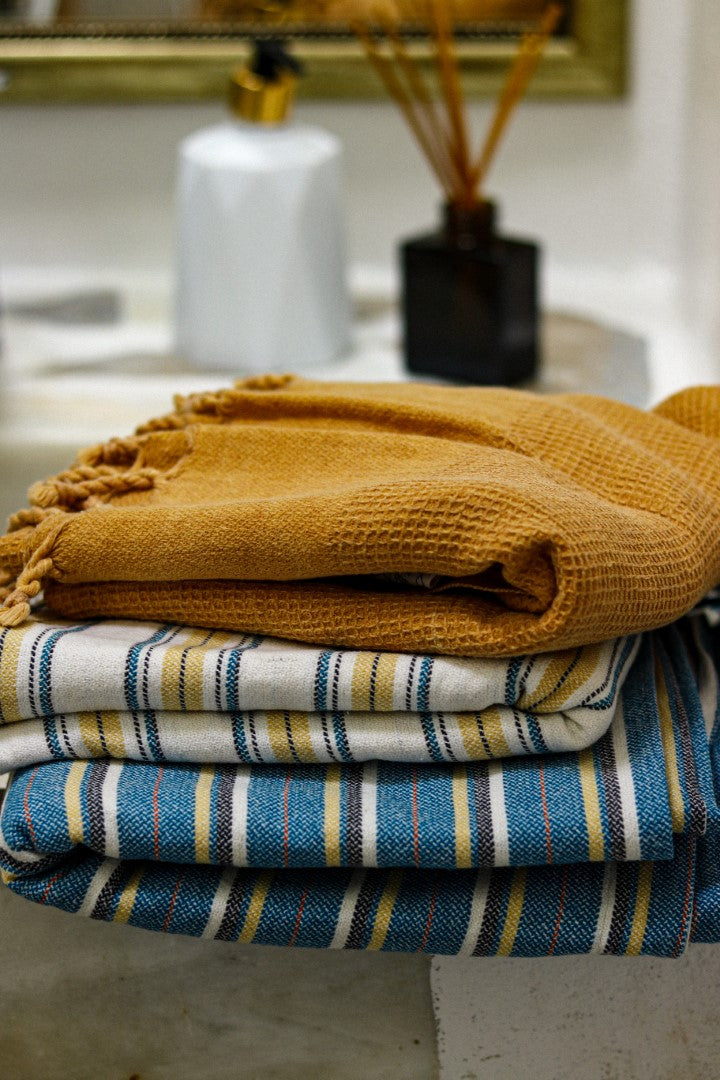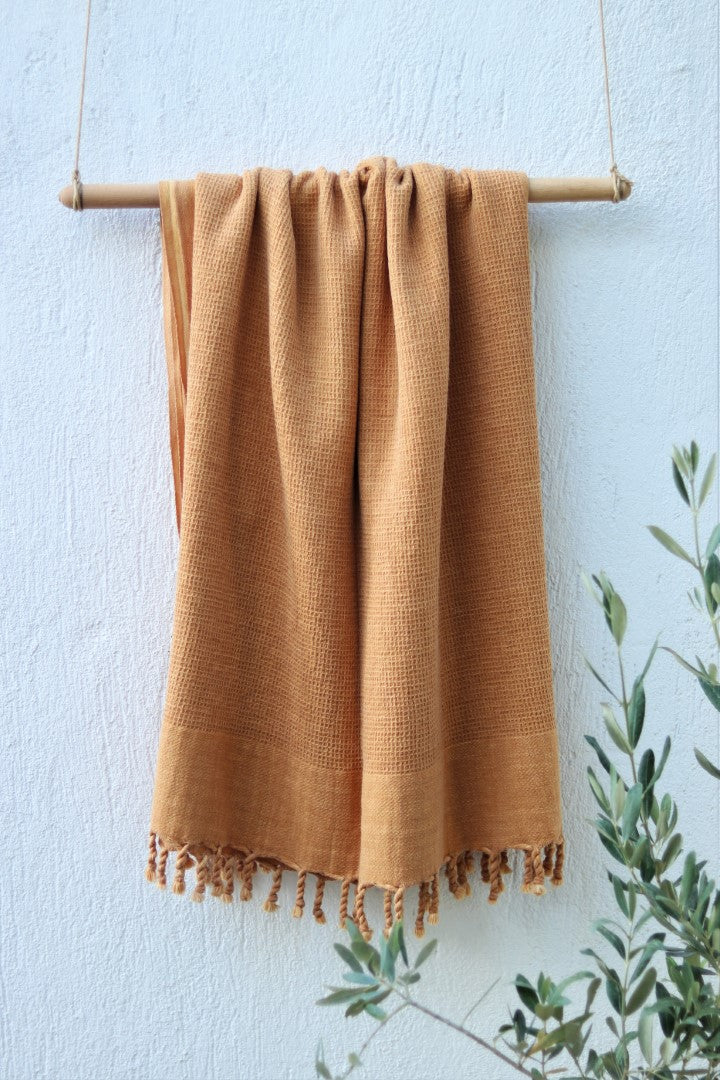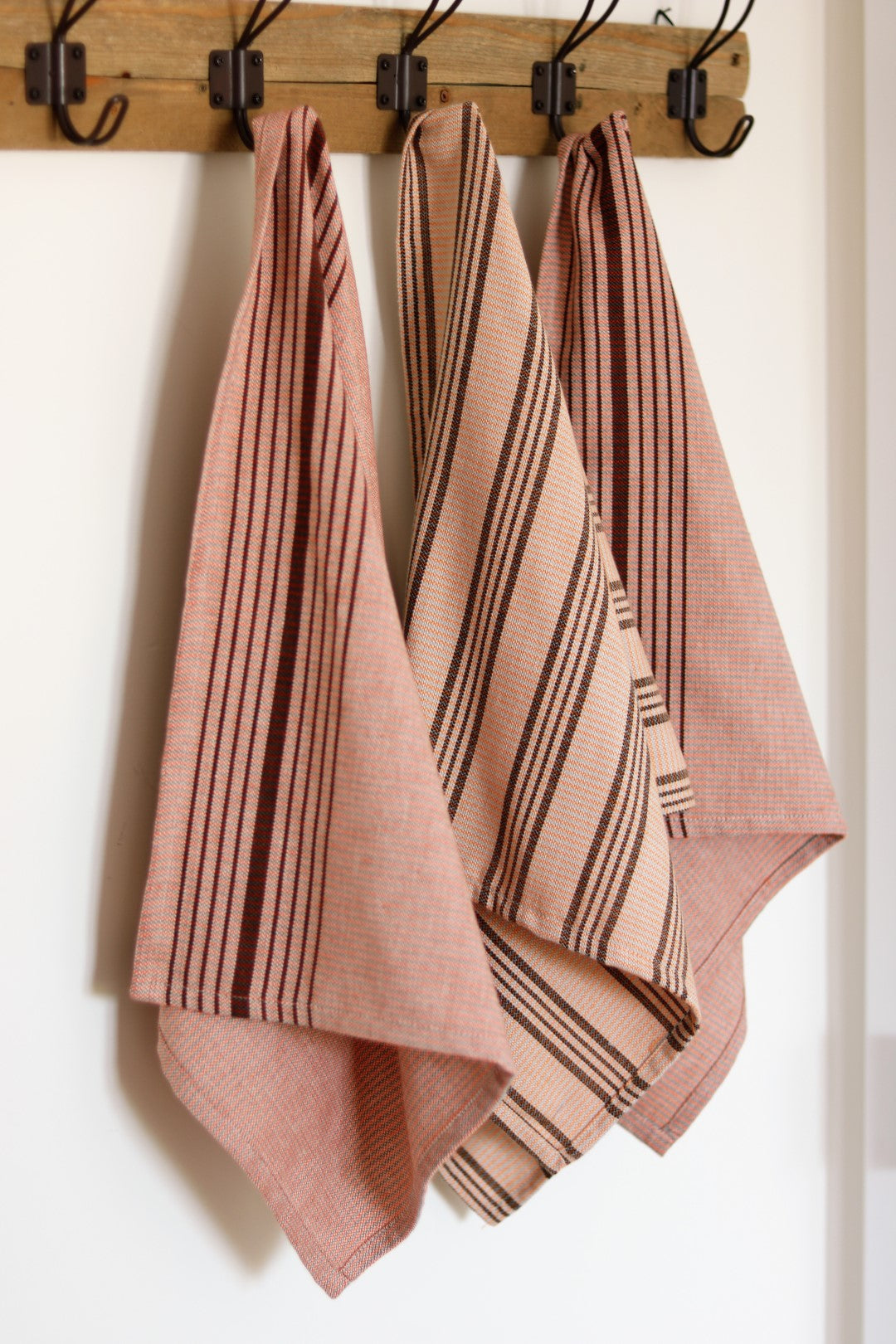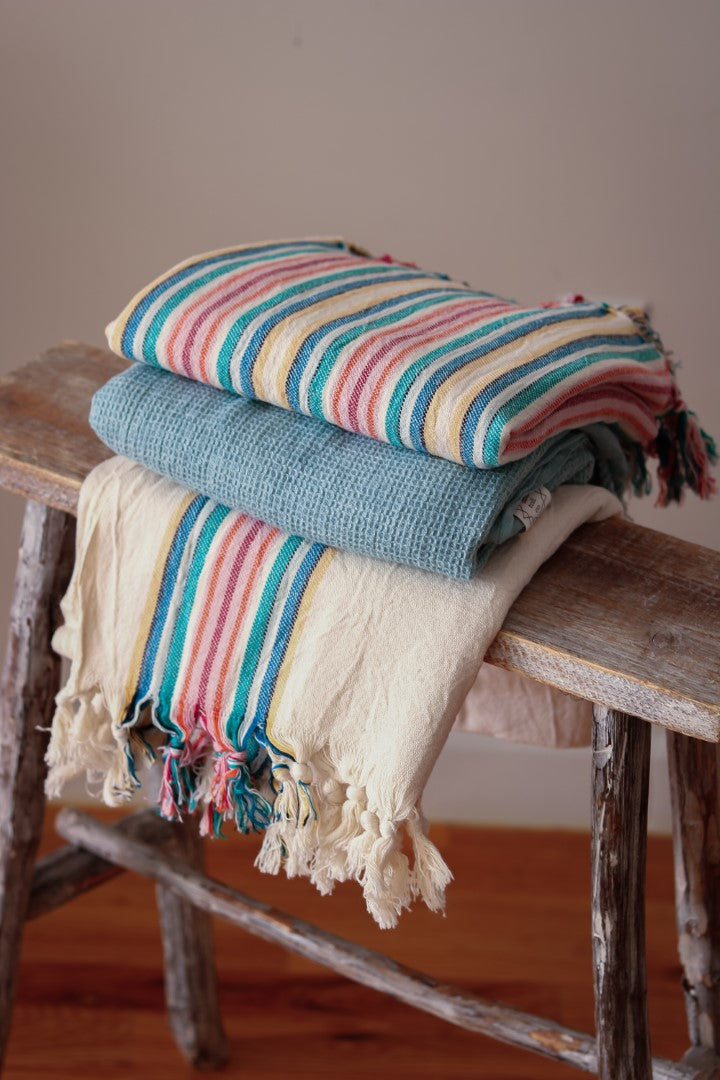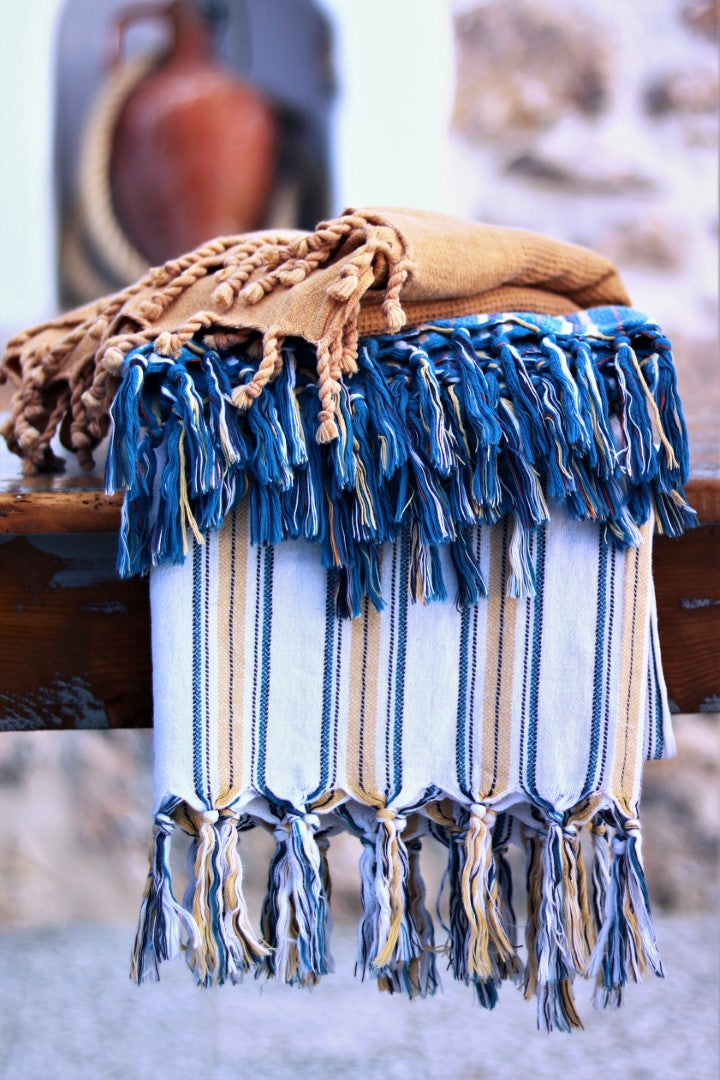That musty, sour smell clinging to your bath towels is a classic laundry problem. It’s not just a sign of dampness—it’s a tiny ecosystem of bacteria and mildew that has set up camp in the fibers.
When a towel is used, it picks up more than just water. It absorbs body oils, skin cells, and soap residue. If that towel doesn't get a chance to dry out completely and quickly, you've created the perfect breeding ground for smelly bacteria to thrive.
It’s a straightforward chain reaction: moisture gets trapped, bacteria flourish, and funky odors are the result.
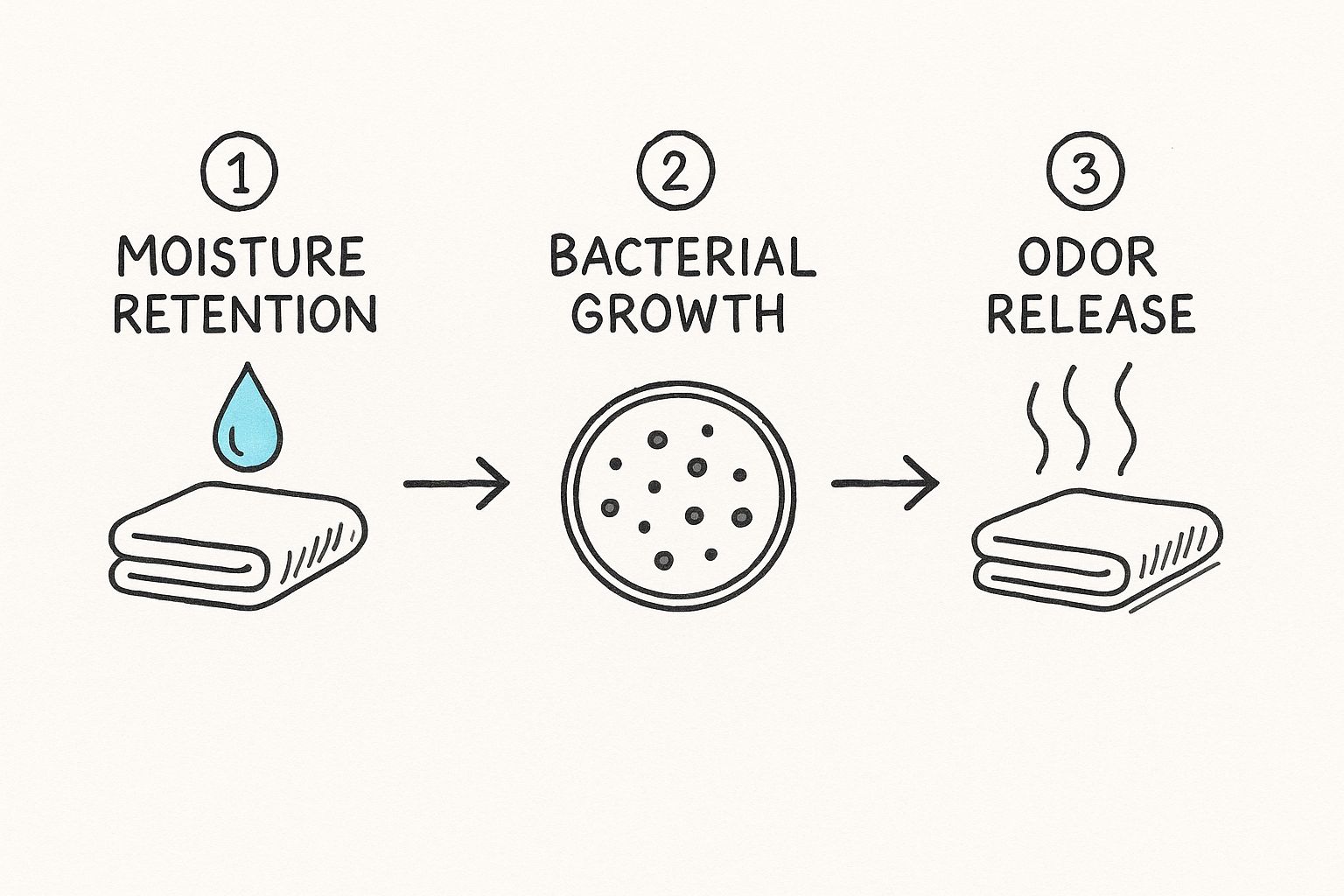
As you can see, lingering moisture is the real culprit here, kicking off the whole cycle of microbial growth that leads to that unpleasant smell.
Why Your Regular Wash Cycle Isn't Cutting It
Ever wonder why a standard wash doesn't always knock out the funk? It usually comes down to a few common laundry habits that are surprisingly counterproductive.
- Detergent and Softener Overload: It feels logical to use more soap for a dirtier job, but with towels, it backfires. Too much detergent or fabric softener leaves behind a waxy residue that coats the fibers, trapping both moisture and bacteria. It essentially waterproofs the towel, making it impossible to get truly clean.
- The "Mostly Dry" Mistake: Putting away a towel that's even slightly damp is a recipe for mildew. Without proper airflow to get them bone-dry, they’ll start to smell in the linen closet.
- A Crowded Washer: We've all been tempted to stuff that last towel in, but an overloaded machine can't do its job. Water and detergent can't circulate properly, meaning dirt just gets moved around instead of washed away, and soap residue is left behind.
This isn't a small problem. The global odor eliminator market was valued at a staggering $1.2 billion in 2021 and is on track to hit $2.8 billion by 2033. That’s a lot of people fighting smelly laundry. In fact, nearly 60% of households in temperate climates struggle with towel odors.
Often, the persistent damp smell is mildew. For a deeper dive, this guide to removing mildew safely from surfaces offers some great, comprehensive tips.
Key Takeaway: The core reason for smelly towels isn’t just dirt; it's a perfect storm of trapped moisture, product buildup, and the resulting bacterial growth. A normal wash often can't break that cycle.
Understanding the why is the first step. Once you know what's causing the problem, you can fix it for good. It's also worth noting that different fabrics require different care. For example, learning how to care for your Turkish towel can help prevent these issues before they even start.
So, how do you strip away that buildup and get your towels fresh again? The quickest, most effective method involves a simple two-cycle wash using basic household staples: one cup of white vinegar and a half-cup of baking soda.
Here's a quick breakdown of this immediate odor-busting technique.
Immediate Odor Removal Method
| Cycle | Ingredient | Action and Purpose |
|---|---|---|
| Cycle 1: The Vinegar Wash | 1 cup of white vinegar | Run a hot water cycle with only vinegar (no detergent). The acid breaks down mineral deposits and oily residue, releasing trapped grime and bacteria from the fibers. |
| Cycle 2: The Baking Soda Wash | ½ cup of baking soda | Run a second hot water cycle with just baking soda. This neutralizes any remaining odors and washes away the loosened buildup, leaving towels soft and fresh. |
This one-two punch is incredibly effective because it tackles both the residue and the smell without resorting to harsh chemicals. After these two cycles, just toss them in the dryer until they are completely dry, and they should be good as new.
The Deep Clean Method for Stubborn Odors
Let's be honest, sometimes a regular wash cycle just doesn't cut it. You pull your towels out of the dryer, expecting fresh, fluffy comfort, but instead, you're hit with that same old musty, sour funk. It's frustrating.
When that happens, you need to bring out the big guns. This two-cycle deep clean is my go-to method for rescuing towels that seem beyond saving. Think of it less as a wash and more as a complete restoration for your linens.
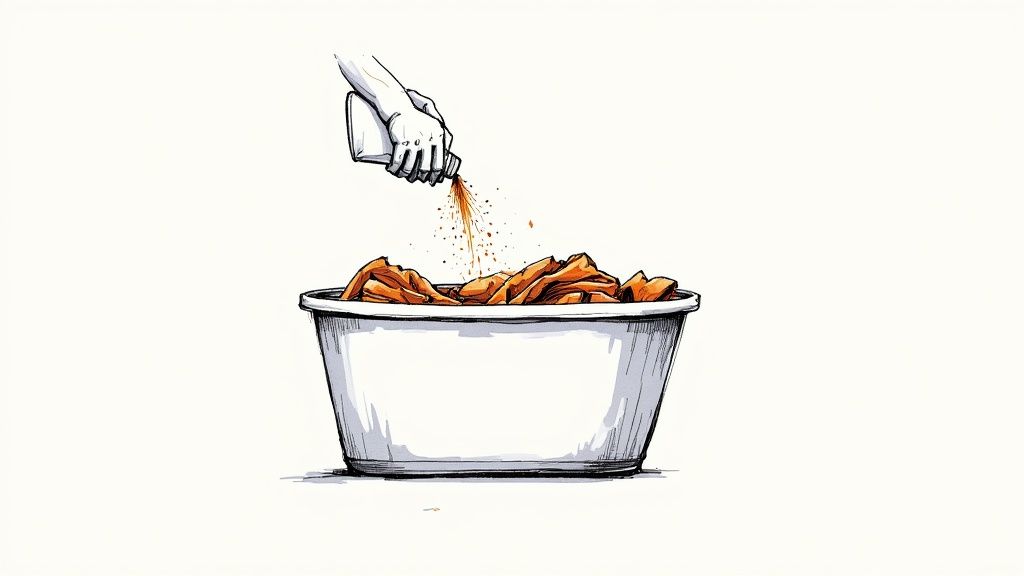
This process is a lifesaver for towels you accidentally left in the hamper too long or that pile you forgot in the washing machine overnight. Using two simple household staples, you can strip away the gunk and kill the smell at its source.
The First Cycle: Vinegar to the Rescue
First things first, gather up all your funky towels and get them into the washing machine. The key here is not to cram them in. You want to give them plenty of space to tumble and slosh around, which allows the water to really work its way into every single fiber.
Now, crank up the heat. Set your machine to the hottest water setting the towels can handle—for most cotton towels, this is the "hot" setting. A quick peek at the care tag can confirm this. That high temperature is your best friend for killing off the bacteria and mildew causing all the trouble.
Here's the crucial part: skip the detergent. Instead, pour one cup of white distilled vinegar directly into the drum with the towels. Run a full wash and rinse cycle. The acetic acid in the vinegar is a powerhouse; it dissolves the gross buildup from detergent, fabric softener, and hard water minerals that are trapping all those odors.
Why This Works: Vinegar is a natural clarifier. It acts like a reset button, stripping away the residue that locks in moisture and bacteria. This preps the towel fibers to get truly clean in the next step.
The Second Cycle: Baking Soda for Neutralization
Okay, once the vinegar cycle is finished, don't move the towels. Just leave them right there in the washer. It's time for part two of our one-two punch against odor.
Sprinkle a half-cup of baking soda directly over the wet towels. Again, no detergent. Just the baking soda. Run another complete wash cycle, still on the hottest water setting your towels can take.
The baking soda works its magic by neutralizing any stubborn acidic smells the vinegar didn't quite vanquish. It also acts as a gentle scrubber, helping to soften the fibers and get them feeling fresh again.
Critical Rules for Success
This deep-clean method is incredibly effective, but you have to follow a couple of non-negotiable rules. Sticking to these will give you amazing results and help you avoid a messy, ineffective laundry experiment.
- Never Mix Vinegar and Baking Soda: I can't stress this enough—do not pour both into the same wash cycle. When you combine them, they create a fun little fizzy science project that immediately neutralizes them both. What you're left with is basically salty water that has almost zero cleaning power. Two separate cycles are essential for each ingredient to work its magic.
- Dry Completely and Immediately: The second that final cycle ends, get those towels into the dryer. Tumble dry them on high heat until they are completely bone-dry. I mean it—no hint of dampness. Even a little moisture is an open invitation for mildew to come right back and ruin all your hard work.
Following this two-part process can bring even the most hopelessly smelly towels back from the brink, leaving them fresh, clean, and finally odor-free. This is what you do when nothing else seems to work.
Taking On Seriously Stubborn Towel Odors
Sometimes, the trusty vinegar and baking soda trick just doesn't cut it. When you're dealing with smells that have settled deep into the fibers—think gym towels left in a bag too long or old towels with years of buildup—you need to bring in the heavy hitters.
These next-level methods go beyond surface cleaning to break down the biological and chemical gunk that causes those persistent, funky smells.

Think of this as your advanced toolkit for restoring towels to a state of true, deep-down freshness.
Give Oxygen Bleach a Try
Step away from the chlorine bleach. While it's a powerful disinfectant, it's notorious for fading colors and weakening cotton fibers over time. A much better choice is oxygen bleach, which usually comes in a powdered form (look for sodium percarbonate on the ingredient list).
It's a color-safe powerhouse that deodorizes and brightens by releasing tiny oxygen bubbles in the wash. These bubbles actively break apart organic grime and kill the bacteria causing those sour smells.
- How to Use It: Simply add one scoop of the powder right into the washing machine drum with your towels.
- Best for: Reviving dingy whites and safely deodorizing colored towels that just won't come clean.
- Pro Tip: For a really intense treatment, dissolve some oxygen bleach in a bucket of hot water and let the towels soak for a few hours before running them through a normal wash cycle.
Outsmart Hard Water with Borax or Washing Soda
If you live in a hard water area, you're fighting a constant battle against mineral deposits. These minerals latch onto your towel fibers, making them stiff and creating a perfect environment for soap residue and bacteria to thrive. This buildup is a major cause of recurring odors.
Enter laundry boosters like borax or washing soda.
These alkaline powders are brilliant because they soften the wash water, allowing your detergent to work much more efficiently. They prevent that nasty mineral and soap buildup from ever getting a foothold, stopping odors before they start.
Just toss a half-cup of either borax or washing soda in with your regular detergent. For anyone dealing with hard water, this small step is an absolute game-changer for getting your laundry truly clean.
Target the Odor Source with Specialty Cleaners
For the absolute worst offenders—mildew, pet smells, or that unforgettable funk from serious sweat—you might need a product specifically designed to dismantle the problem at a molecular level.
- Enzymatic Cleaners: These are your secret weapon against organic messes. They use targeted enzymes to literally digest the proteins in things like sweat, body oils, and bacteria, eliminating the source of the smell completely.
- Laundry Sanitizers: If you're concerned about germs, especially when washing in cold water, these additives are for you. They’re formulated to kill 99.9% of bacteria, ensuring your towels are hygienically clean and odor-free.
It's no surprise that these products are becoming more popular. Up to 30% of consumers say they struggle with towels that never seem to smell fresh, which has fueled a 25% increase in the sales of laundry additives like oxygen bleach and enzyme cleaners since 2020.
Understanding how to tackle tough smells is a science. In fact, many of the same principles apply to other areas of home cleaning. The strategies to eliminate stubborn pet odors for good offer great insights into deep cleaning and source elimination that work just as well for musty towels as they do for carpets.
Mastering Your Drying Routine to Prevent Smells
Washing your towels correctly is a huge step, but it's only half the battle. If your drying routine is off, you’re basically rolling out the welcome mat for the mildew and bacteria that cause those musty smells. Getting towels completely dry, and doing it fast, is the secret to stopping odors before they even think about starting.
Before a towel even goes into the dryer, give it a couple of good, hard snaps. Seriously. This little trick helps separate and fluff up all the tiny cotton fibers. Why does that matter? It lets the hot air circulate way more freely, which dramatically cuts down on drying time. Think of it as giving your dryer a running start.
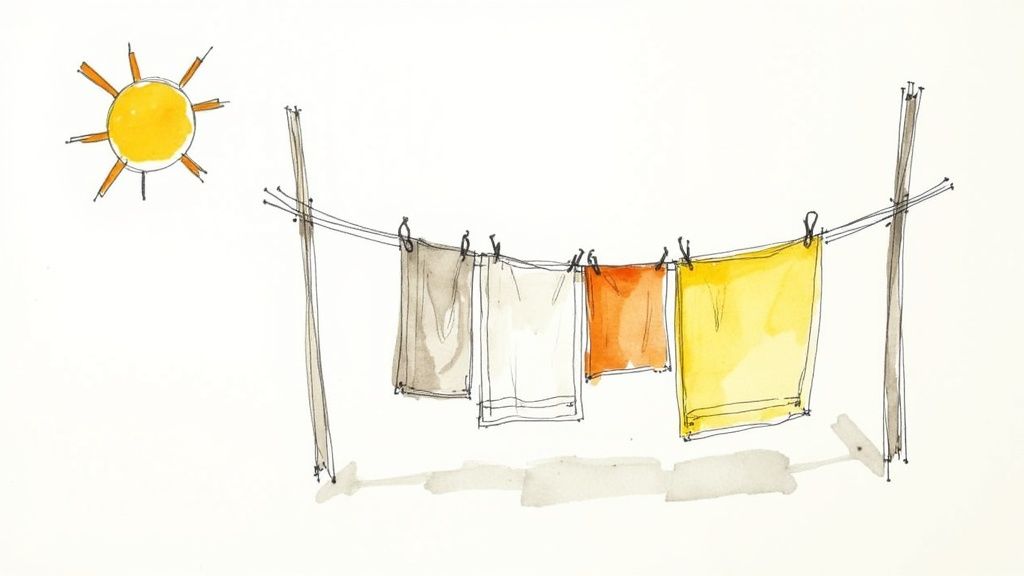
Optimizing Your Dryer Performance
We've all been there—stuffing the dryer to the brim to get the laundry done faster. But with towels, that’s a recipe for damp spots. When they're packed in too tightly, they just end up steaming each other, trapping moisture right where you don't want it. For the best results, stick to small or medium loads. Give them room to tumble.
Want a pro tip? Toss in a few wool dryer balls. They’re fantastic for a few reasons:
- They create space. The balls bounce around between the towels, keeping them from turning into one big, heavy clump.
- They boost airflow. By separating the towels, warm air can get to every inch of fabric.
- They absorb moisture. Wool is naturally absorbent, so the balls actually help pull a little moisture out of the towels, speeding things up even more.
The goal here is bone-dry. I mean it. Even the slightest hint of dampness is enough for mildew to throw a party once that towel is folded and tucked away in a dark linen closet. Always double-check them before you put them away.
It's clear people are paying more attention to this stuff. The global bath towel market is now valued at a whopping $11.3 billion, and some reports show that up to 45% of people are washing their towels after just a few uses. With that much washing, proper drying is non-negotiable to keep them smelling fresh. You can discover more insights about the bath towel market on gminsights.com.
Smart Air-Drying Strategies
If you're skipping the dryer and letting your towels air-dry, your new best friend is circulation. Whatever you do, don't just hang a damp towel on a single hook or fold it over on itself. That’s a direct invitation for mustiness, as moisture gets trapped in the folds.
The right way is to drape it over a towel bar or a drying rack, spreading it out as much as you can. You want to expose the maximum surface area to the open air so it can dry evenly and quickly.
It also helps to choose the right material from the start. Some fabrics are just naturally better at drying fast. For example, understanding what Turkish cotton is can be a game-changer. Its unique long fibers are incredibly absorbent but also surprisingly quick to dry, which really cuts down on the risk of mildew.
Building Habits for Long-Term Freshness
Alright, you've successfully stripped away all that funky gunk and your towels smell great again. The real trick now is keeping them that way for good. Shifting from a frantic, one-time fix to a simple, proactive routine is the secret to making musty towels a thing of the past.
This isn't about adding more chores to your list; it's about being smarter with the ones you already do. A few small tweaks to how you wash, dry, and store your towels can make a world of difference.
Rethink Your Laundry Routine
How you wash your towels has a massive impact on whether they stay fresh or start to smell funky again. Tiny adjustments here can stop that residue buildup that loves to trap moisture and bacteria. This is about preventing the problem before it even starts.
First off, how often are you washing them? A bath towel really should hit the laundry pile after about three to four uses. Any longer than that, and you're letting body oils and skin cells build up, which is basically a buffet for odor-causing bacteria.
Next, let's talk detergent. It feels logical to use more soap for a dirtier job, but with towels, that’s a huge mistake. Overdoing it leaves a sticky film on the fibers that actually attracts more grime and locks in moisture. Stick to the manufacturer's recommendation, or even try using a little less.
Crucial Tip: If you do one thing, make it this: stop using liquid fabric softener on your towels. It might promise fluffiness, but it works by coating fibers in a waxy, water-resistant film. This ruins absorbency and creates the perfect damp breeding ground for mildew.
Master Proper Towel Storage
Where and how you store your towels is just as important as how you wash them. The mission is simple: eliminate any chance for moisture to hang around.
The golden rule is to make sure your towels are completely bone-dry before you even think about folding and putting them away. Even a tiny bit of dampness is an invitation for that musty smell to creep back in, especially in a dark closet.
And where you store them matters. A steamy bathroom is the worst place for your clean, dry towels.
- Find a Well-Ventilated Spot: A linen closet with good airflow is your best bet. Try not to cram them in too tightly—give them some breathing room.
- Hang After Every Single Use: This is non-negotiable. Never, ever leave a damp towel in a heap on the floor or stuffed in a hamper. Spread it out on a towel bar so it can dry quickly between uses.
These habits stop moisture dead in its tracks. It's also worth noting that the towel's material can be a game-changer. Some fabrics are naturally more breathable and dry faster, which you can learn more about in our guide comparing Turkish towels vs regular towels.
Finally, get into the habit of a monthly maintenance wash. Once a month, just toss your towels in a hot cycle with a cup of vinegar, like a mini deep clean. This little bit of preventative care will strip away any new residue before it becomes a smelly problem, keeping your towels soft, absorbent, and fresh for the long haul.
Common Questions About Smelly Towels
Even when you think you’ve got the routine down, a few persistent questions always seem to pop up. Let's dig into some of those common "what-if" scenarios that can make the difference between musty towels and perfectly fresh ones.
Why Is Fabric Softener So Bad for Towels?
I know it sounds completely backward, but that bottle of fabric softener is probably one of the biggest reasons your towels stink. Liquid softeners and dryer sheets work by leaving a waxy, water-repelling film on the fabric fibers.
This coating creates a double-whammy for towels:
- It traps moisture and bacteria. That waxy layer seals in dampness, turning your towel into a perfect breeding ground for mildew.
- It ruins absorbency. The coating makes the fibers less able to soak up water, which is, of course, a towel's entire job.
Think of fabric softener as a tiny raincoat for each fiber in your towel. It makes them repel water, which is the exact opposite of what you need. Ditching it is one of the simplest and most effective changes you can make.
How Often Should I Deep Clean My Towels?
You definitely don't need to do the full vinegar and baking soda deep clean with every single wash. That would be overkill. For most homes, it’s best used as a regular maintenance treatment.
A good rule of thumb is to run this deep-cleaning cycle about once a month. This helps dissolve any fresh buildup from detergent residue or hard water minerals before it gets a chance to lock in odors.
That said, if you accidentally leave a wet load in the washer overnight (we've all been there!) or if you notice that musty smell starting to creep back in, go ahead and do an extra deep clean.
What If the Smell Still Lingers After Everything?
This is the really frustrating part. You've tried the vinegar, the baking soda, and maybe even an oxygen bleach soak, but there's still a faint, funky smell. When this happens, it's time to stop looking at the towels and start looking at your washing machine.
Washers, especially the front-loading kind, are notorious for trapping gunk. Mold and mildew can build up in the rubber door seal, inside the detergent dispenser, and even in the drum itself. That grime then gets transferred right back onto your supposedly clean laundry.
Try running an empty cleaning cycle on the hottest setting with two cups of vinegar. Make sure to wipe down the inside of the rubber gasket, too. The single best thing you can do going forward is to leave the washer door open between loads to let it air out completely. A clean machine is the first step to truly clean towels.
At Anatolico, we believe that the right materials make all the difference. Our OEKO-TEX certified Turkish towels are designed with long fibers that are naturally absorbent and quick-drying, making them less prone to mildew and odors. Discover the difference artisan-made quality can make.

